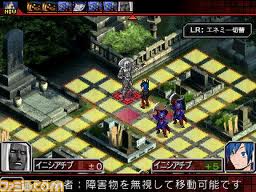I’ll admit, it feels a little bit silly blogging about a game that’s apparently already out-of-print, but there’s a lesson to be found in Shin Megami Tensei: Devil Survivor Overclocked, and I’ll be damned if I’m not going to point it out whether you get to experience it or not.
Devil Survivor is an SRPG with turn-based isometric battles in the tradition of the genre. The entire game is played on the clock; you get seven days to save the world, and every major game action — whether initiating a major battle or having a plot-progressing conversation — takes half an hour off the clock. Also, the protagonists sleep, because, you know, they’re supposed to be humans rather than automatons trapped in a video game.
You would think that this would eliminate the grind altogether, but this isn’t the case. If you find that you’re simply not strong enough to take on one of the game’s many difficult battles, you can enter a free battle at no in-game time cost whatsoever. You can stockpile money, gain levels, and overpower yourself as much as you like.It would seem that an SRPG is just about the last place you’d want to be subjected to a grind, but Devil Survivor actually manages to make it work, by inspiring the player to set very specific goals to the grind. The playable team in Devil Survivor is so malleable, so very subject to the player’s wants and whims, that a very specialized team can be created for any situation. Sure, the main characters remain (mostly) constant, but each main character gets to be flanked by two of a possible stable of 16 demons. Demons can be bought, and demons can be created through the fusion of other demons, and a little bit of play time reveals that it doesn’t take all that many battles to create a highly specialized team. If you’re fighting a series of enemies that are weak against fire, finding four or five demons with fire abilities isn’t all that difficult. If you’re fighting a battle that includes the condition of needing to win within three turns, carrying a stable of demons that can double up on attacks might be the way to go.
Strategy in an SRPG tends to be a matter of getting the most out of a very limited set of variables. You have a set team, and you have to figure out some way to get that team to work together, to make the most out of whatever abilities that team has. Devil Survivor has some of this, but just as much of the strategy is in building the team that’s going into battle.
If you pay attention during the battles that you win, you can start forming generalized strategies right off the bat — demons with the “Anger Hit” ability work well with a hero that has the “Marksman” ability, for example, given that the never-miss Marksman supercedes the 50% success rate of the Anger Hit. Given that you have three active ability slots per demon, it helps to slot a healing spell in at least one of those if possible to give the player the greatest flexibility of attack and support. The more likely a paralyzing or petrifying skill is to hit, given whatever aids and buffs are present in the battle, the more useful it happens to be. You can build teams to take advantage of all of these, and for much of the game, fielding a team that simply exists to function in harmony with itself is enough.
There are some very, very difficult battles in the game, however, particularly late, but again, if you’re paying attention, they don’t feel unfair. When you start a battle, there is no mystery to the specific enemies you are fighting; all of the information about those enemies, including their abilities, strengths, weaknesses, and stat boosts, are immediately made available at the start of each battle. By knowing everything about these enemies, the player can then enter into free battles, with the goal of recruiting a cadre of demons that will best fight that specific battle.
Usually, it only takes two or three free fights before you’re ready to go in guns blazing, ready to shred up the enemies that seemed so intimidating not long before. Granted, “two or three free fights” can take an hour to an hour and a half depending on the player’s approach, but there’s a very immediate sense of progress. This isn’t walking back and forth and triggering random battles for an hour just to trigger a minor stat boost; this is grinding with a goal.
Does it undercut the urgency of the game, somewhat removing the idea that the player pays a price for every action? Sure it does. But as a way to keep a player interested in what is already a fairly long and difficult game, it is perfect. The grind is not boring, it’s just one more element to the “S” in this particular SRPG.










